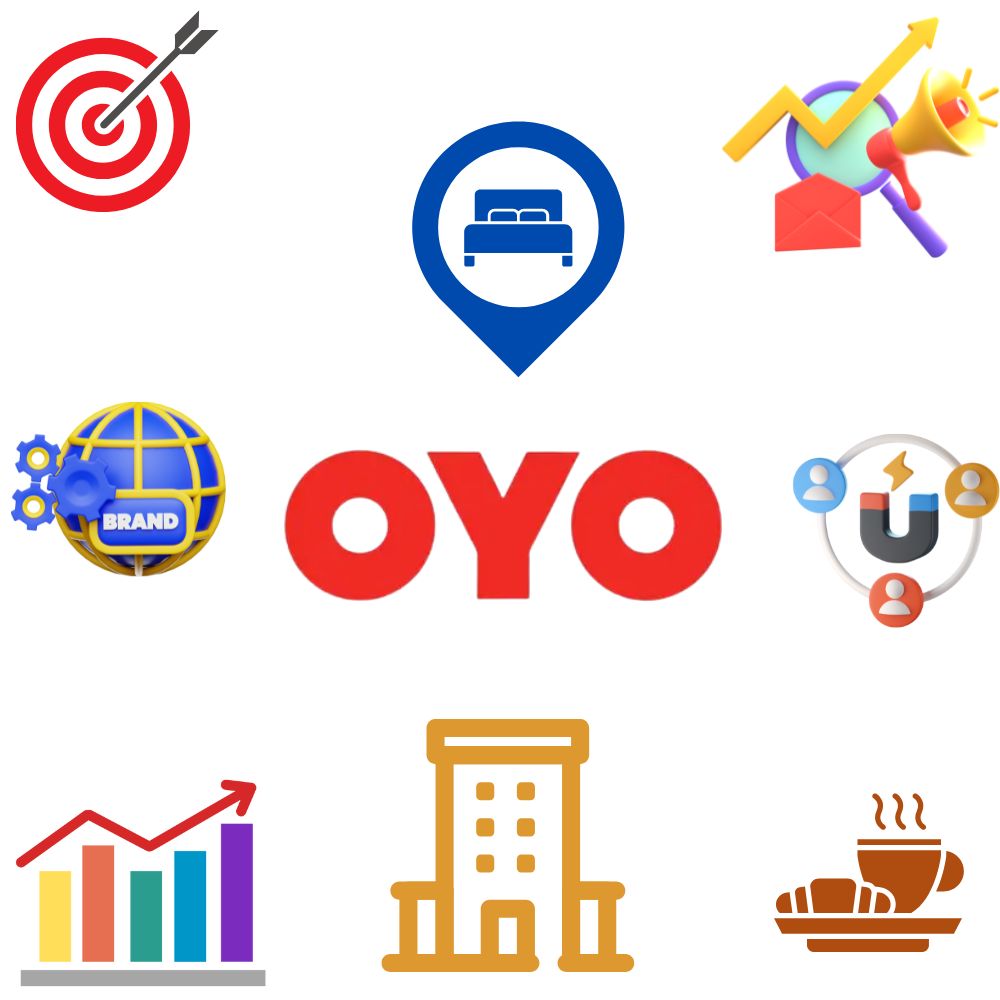Most travelers looking for budget-friendly hotels have come across OYO Rooms at some point. What began as a simple idea to make affordable stays easier to find has grown into one of the biggest hospitality brands in the world. With over a million rooms listed worldwide, OYO has transformed from a small startup into a global travel companion.
This growth didn’t happen just because of low prices. The marketing strategy of OYO blends smart digital campaigns, striking visuals, and strategic partnerships to connect with its audience. It focuses on building a relationship not only with travelers but also with property owners who trust the platform to bring them guests.
From creative social media promotions to collaborations with airlines and travel agencies, OYO marketing keeps the brand in the spotlight. This case study of OYO explores its origin, strategies, and standout campaigns that shaped its success story.
The journey ahead will unpack how the OYO strategy turned a local idea into a worldwide brand loved by millions.
Origin & Evolution of OYO
The origin of OYO traces back to 2013, when a young entrepreneur named Ritesh Agarwal spotted a gap in India’s hotel market, a move that later reshaped modern hotel marketing strategies. Travelers wanted affordable rooms, but most budget hotels lacked standard facilities and reliable service. Ritesh, only 19 at the time, decided to fix that by launching Oravel Stays, which later became OYO Rooms.
OYO began with a simple promise: clean, comfortable, and standardized rooms at budget-friendly prices. The idea clicked instantly. Property owners liked the model because it brought them more guests, while travelers appreciated knowing exactly what to expect.
In just a few years, OYO expanded beyond India, stepping into markets like China, the UK, and Southeast Asia. The OYO strategy focused on aggressive growth, fueled by technology and a strong OYO marketing approach that promoted consistency, affordability, and trust.
Today, the brand operates in dozens of countries, proving how a small startup idea can evolve into a global name through vision, execution, and the right marketing moves. This case study of OYO is proof that hospitality success can start with one determined idea.
Marketing Strategy of OYO
The marketing strategy of OYO revolves around one central goal: making the brand the first choice for budget-friendly, standardized stays. To achieve that, OYO uses a mix of technology-driven promotions, bold advertising, and customer-focused campaigns.
The company positions itself as more than just a booking platform. It’s a travel partner that ensures guests know exactly what they’re getting, no matter where they go. This trust factor is a big part of the OYO marketing playbook.
OYO’s approach blends online and offline channels. On one side, digital marketing targets travelers through search engines, social media, and the OYO app. On the other hand, offline visibility comes from billboards, metro ads, and event sponsorships. This balance helps the brand reach everyone from tech-savvy millennials to families booking weekend trips.
Another key OYO strategy is partnerships. By working with airlines, online travel agencies, and local tourism boards, OYO keeps its name visible at every stage of a traveler’s journey. It’s not just about selling rooms, it’s about staying top-of-mind whenever someone thinks about traveling.
Key Marketing Channels Used by OYO
To make its presence felt worldwide, the marketing strategy of OYO uses a smart mix of channels. Each one is designed to attract new guests, keep existing ones engaged, and strengthen the brand’s position.
Digital Marketing
OYO uses search engine ads, social media promotions, and app notifications to reach travelers instantly. This OYO marketing push ensures deals and offers are just a click away.
Offline Advertising
Billboards, metro station ads, and radio spots help OYO reach audiences who aren’t always online. It keeps the brand visible during daily commutes.
Partnerships & Collaborations
Strategic tie-ups with airlines, online travel agencies, and tourism boards expand reach and add credibility. This is a key OYO strategy for boosting bookings.
PR & Events
From sponsorships to travel expos, OYO uses public events to connect with customers face-to-face, building trust beyond screens.
Notable Campaigns (Case Study of OYO)
OYO has never been shy about using creative campaigns to stand out. Each initiative reflects the marketing strategy of OYO, which blends humor, emotion, and practicality to connect with travelers. These campaigns didn’t just promote rooms, they built a brand personality that’s friendly, relatable, and trustworthy.
#AurKyaChahiye Campaign
This campaign was all about keeping things simple. OYO showcased how guests could enjoy clean rooms, Wi-Fi, and great service at affordable rates. The phrase “Aur Kya Chahiye?” (What more could you want?) became instantly catchy. Social media posts, memes, and short videos made it shareable, helping OYO marketing reach millions of young travelers.
Valentine’s Day “Relationship Mode”
For couples looking for a quick getaway, OYO introduced a “Relationship Mode” feature in its app. It offered romantic stay options and discounts just for the season. The quirky tone, paired with playful visuals, generated massive online buzz and positioned OYO as a brand that understands its audience’s lifestyle.
“Sanitized Stays” Post-COVID
When the pandemic hit, travel confidence dropped drastically. To address safety concerns, OYO launched “Sanitized Stays,” a campaign that highlighted strict cleaning protocols, trained staff, and contactless check-ins. This OYO strategy not only reassured guests but also brought property owners on board by giving them clear safety standards to follow.
Regional Festive Offers
OYO taps into India’s love for festivals by rolling out seasonal discounts during Diwali, Holi, Durga Puja, and other regional celebrations. These campaigns feature festive-themed creatives and localized messaging to connect with specific markets. The approach drives high bookings during peak travel seasons while keeping OYO relevant in cultural conversations.
“Stay Close to What You Love”
This campaign targeted travelers seeking stays near landmarks, beaches, or event venues. It encouraged people to plan trips that matched their passions, be it music festivals, heritage sites, or nature escapes. It positioned OYO marketing as not just about affordability but also about enhancing travel experiences.
“Raho Mast” Series
A more fun and casual initiative, “Raho Mast” celebrated the joy of travel with lighthearted content. It mixed humor and inspiration, showing that no matter the destination, OYO could make it stress-free and enjoyable.
Conclusion
The journey from a small startup to a global hospitality leader shows the power of a well-planned marketing strategy of OYO. By mixing technology, creativity, and partnerships, the brand has managed to stay relevant and appealing to millions of travelers.
This case study of OYO proves that success in hospitality isn’t only about offering rooms, it’s about building trust, ensuring consistency, and staying visible through the right channels. From its origin of the OYO story to its bold campaigns, every move reflects a clear vision.
With a focus on affordability, standardization, and insights from customer research, OYO’s marketing continues to evolve to meet changing traveler expectations. The OYO strategy offers valuable lessons for brands aiming to grow fast while staying connected to their audience.
OYO’s rise is a reminder that when marketing strategy meets execution, even a simple idea can change an entire industry.
FAQs
1. What is the core marketing strategy of OYO?
It focuses on affordability, standardization, and a strong digital presence.
2. How has the marketing strategy of OYO helped its growth?
By using aggressive promotions, app-based convenience, and customer trust-building.
3. Which campaigns highlight the marketing strategy of OYO?
Campaigns like “Stay in Your Comfort Zone” showcased its value-driven approach.
4. How does the marketing strategy of OYO differ globally?
It adapts to local markets while keeping affordability and consistency central.
5. What can businesses learn from the marketing strategy of OYO?
The importance of tech-driven solutions, brand positioning, and customer-centric campaigns.


















Leave a Comment